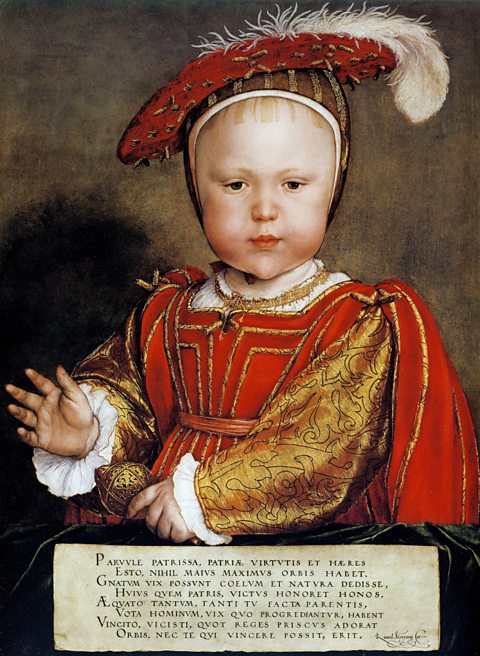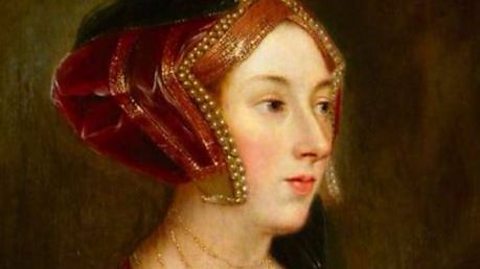A man of extremes
Henry VIII is one of our most renowned monarchs. He was a larger than life king who established one of the most glittering courts in Europe. However, he was also a spoiled prince used to getting his own way and ruthless when his desires were thwarted.
Henry turned the country upside down in pursuit of Anne Boleyn, changing the nation's official religion, annulling his first marriage and executing once-favoured advisers to secure his marriage to her. However, when Anne failed to produce a son to carry on Henry's legacy, even she wasn't safe.
A monarch's desires
The king was fascinated with Anne Boleyn, who had arrived from the French court and was one of his wife's ladies-in-waiting. Henry had already slept with her sister, Mary, but Anne refused to be his mistress. She had higher ambitions.
Kate Williams explores Henry and Anne's blossoming romance at Hever Castle in Kent
A lusty monarch
Dr Kate Williams
Henry VIII is well known as the lusty, powerful monarch who had six wives and broke with the Church of Rome. But his actions were also driven by vulnerability – his desperate desire for a son to secure his dynasty and his unrequited love for Anne Boleyn.
While Anne was living here in Hever Castle in the 1520s, Henry inundated her with love letters. I can just imagine her standing here looking out, waiting for the latest passionate words from the king.
And Henry was desperate to get her into his bed. He’s writing to her here: “I send you this letter begging you to give me an account of the state you are in.” And then he goes on to say: “I send you by this bearer, a buck killed late last night by my hand, hoping, when you eat of it, you will think of the hunter.”
But Anne played hard to get. She didn’t want to be one of his mistresses. She wanted to be the queen.
Henry was stilled married to Catherine of Aragon but he no longer loved her. She was the wrong side of 40 and had failed to bear him a male heir to secure his dynasty.
In contrast Anne was tempting and exotic. Groomed at the French court she could sing, dance and even play the lute. She was at least 10 years younger than Catherine and Henry was convinced that she would be able to provide him with an heir.
This book is as close as we can get to Anne, it’s her beautiful illustrated Book of Hours – a prayer book she would have treasured. And she’s even signed it: ‘Anne Boleyn’.
In another of Anne’s prayer books there is this flirtatious and secret message from Henry and he says here: “If you remember my love in your prayers as strongly as I adore you, then I shall hardly be forgotten because I am yours, Henry R forever.”
And Anne replied writing here: “By daily proof you shall me find, to be to you both loving and kind.” And crucially she has written this under a picture of The Annunciation where the Angel Gabriel is telling Mary that she’s going to have a son.
All the king's men
Henry raised men from modest backgrounds to powerful offices, so they could help him achieve his goals. These men were loyal to the king but they knew that if they failed, Henry had the power to bring them back down to earth.
Click or tap on the portraits below to discover what happened to these four men.
Taking on the Church
When Henry came to the throne, England was a Catholic nation subject to the Pope in Rome.
Henry considered himself a loyal subject of Rome and was given the title ‘Defender of the Faith’ by Pope Leo X after he authored a book attacking the Protestant reformer Martin Luther.
However, the Pope’s repeated refusal to annul Henry’s marriage to his first wife Catherine of Aragon put their relationship under severe strain. The king became convinced his power as a prince came directly from God and was not subject to the Pope.
Race against time
Matters came to a head in January 1533, when Henry and Anne married in secret and she became pregnant. It was a race to annul the king's first marriage and validate the second before Anne gave birth. Parliament passed a series of laws restricting the power of Rome and allowed Thomas Cranmer the Archbishop of Canterbury, to annul the marriage.
Land grab
The Pope promptly excommunicated Henry, banishing him from the Roman Catholic Church. A year later, Henry made himself Supreme Head of the Church of England. Those, including the former Lord Chancellor Thomas More, who refused to recognise his new title, were executed.
Henry VIII then ordered the dissolution of the monasteries. His chief minister Thomas Cromwell oversaw the disbanding of 800 religious houses with their huge wealth and lands going to the crown.
Anne runs out of time
Henry was bitterly disappointed when Anne gave birth to a stillborn boy. She hadn't produced his longed-for heir and Henry had also grown tired of her passionate temper. Anne's many enemies at court scented blood.
Kate Williams reveals how a great royal romance unravelled
Anne runs out of time
In January 1533 Henry VIII married Anne Boleyn in secret and this is a copy of the clock Henry gave to Anne as a wedding present.
Ironically from the moment she was married she would never escape the ticking timebomb – she had to bear him a son.
The queen’s fertility obsessed the court. Her maids and ladies reported back on her menstrual cycles to politicians, spies and ambassadors.
When she became pregnant everyone rejoiced but to Henry’s dismay Anne produced not a son but a daughter – Elizabeth. Henry didn’t want a daughter – a queen might marry a foreign prince and allow England to be dominated by a foreign power. Anne had to give him a son.
Two years later Anne suffered a miscarriage at just under four months. Even worse the unborn child was male. Henry was furious and told Anne bluntly:
‘He would have no more boys by her.’
In Henry’s eyes she had not delivered on her promise. As Anne grieved the loss of her son, I wonder if she had an inkling that her days as queen were numbered.
Henry had found Anne seductive as a mistress, but that passion and independence now seemed likely unwelcome defiance in a wife.
Here Henry is looking down on us and next to Anne is her lady-in-waiting with whom Henry had fallen desperately in love. She was younger, meek and submissive, just what Henry now wanted. But Anne was furious and refused to turn a blind eye to the affair.
By 1536 Henry wanted to get rid of Anne. Anne didn’t help herself – she had close male confidantes and that made people gossip about lovers. One of her ladies in waiting accused her of infidelity. Her position was now extremely dangerous.
The king was ruthless. He ordered an investigation and Anne was tried for high-treason and adultery with five men – including her own brother. The guilty verdict was a foregone conclusion. In his relentless pursuit of a male heir the king killed off the woman for whom he had turned England upside down.

Next in line
Henry had stamped his authority on the country, the church and his household. Now he hoped to finally secure his dynasty.
He already had his next bride in mind - the demure and docile Jane Seymour. They married just 11 days after Anne’s beheading at the Tower of London.
Finally, there was great rejoicing when in October 1537, Jane gave birth to a son Edward at Hampton Court. Henry wept tears of joy as he tenderly held his infant heir.
Edward was to be the king's only legitimate son and 12 days after giving birth, Jane died from complications. Her death plunged Henry into a state of grief.
'Most precious jewel'
Henry was determined to protect the heir he described as "this whole realm's most precious jewel" and no one was allowed to approach or touch the prince without the king's written permission. All of Edward's food was carefully tasted first and the rooms in his household were scrubbed with soap three times a day.

Learn more about this topic:
What did King Henry VIII really want from a wife? document
What did the Tudor king Henry VIII want from his six wives? And why would he execute them, like Anne Boleyn, or divorce them, like Catherine of Aragon?

How could you survive in Tudor England? document
An interactive guide exploring how Tudor king Henry VIII ruled at a time when the average life expectancy was just 35 years old.

The story of Black migrants in England in Tudor times. video
A short film, presented by David Olusoga, which explores the lives of some of the hundreds of Black migrants who were in England during the Tudor period.
